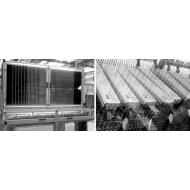All electronic products have to be inspected at different stages during the manufacturing process. As a minimum, the following inspections must be carried out:
- Condition of the printed circuit board. TIC (Test In Circuit): Checking that all the components are present and have been made to the appropriate values.
- Condition of the printed circuit board. Operational: Checking the light source’s electrical input and output parameters, and other internal equipment parameters.
- Condition of the finished product. Operational test with the light source: All the equipment’s basic parameters are checked once again.
These three tests must be completed on all manufactured products. Only then can we implement the BURN-IN system on each product.
Burn-in is a test process implemented on finished electronic equipment in order to detect possible operational faults caused by the premature failure of the electronic components or originating in the manufacturing process. The idea is, therefore, to try to eliminate any possible error that causes premature malfunctioning.
Essentially, the process consists of putting a finished product into operation for a continuous period of 1 to 3 hours (depending on the equipment involved). Test conditions differ according to each model but, generally speaking, we can say that:
- Certain equipment is subject to On/Off switching cycles.
- Other equipment works continuously, being left permanently on.
- Other equipment is made to operate under abnormal conditions; without a bulb, for example.
Further to this, different supply voltages can be established in the system.
In this way, we avoid any weld being left undone or incomplete, or any particularly fragile component being damaged and causing complications for the fitter.
Deciding on whether or not this process is essential depends on the service you want offer. The ballast is ready to work after the checks carried out on the assembly line, but companies that are committed to top quality have to carry out this last test in order to ensure perfect operation.
The BURN-IN system makes it possible to ensure that no errors have been detected in any equipment leaving the warehouse. In ELT’s case, this control process has been improved on over time by applying the knowledge gleaned from the tests. Consequently, we hold the BURN-IN process to be not merely a quality control tool for manufactured products, but rather a dynamic means of improving the quality of the product itself.
Miguel Nicolás, electronic manufacturing



